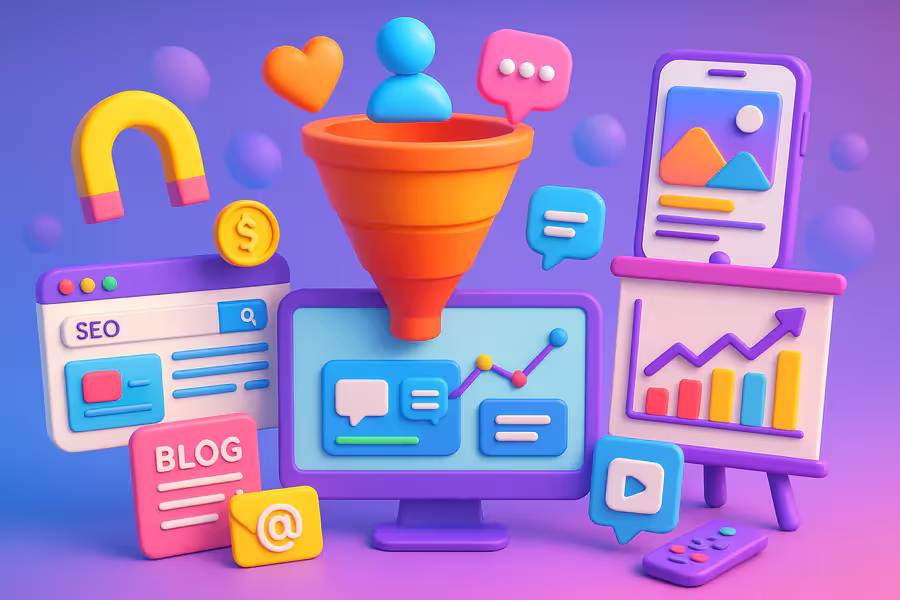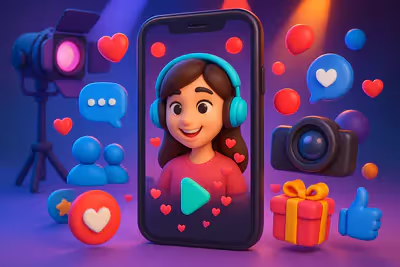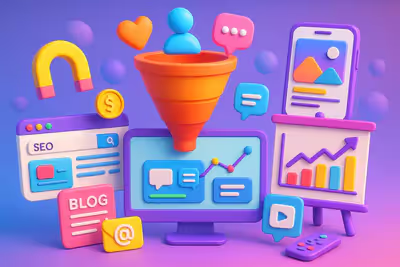The 4 steps to a successful inbound marketing strategy
An effective inbound strategy naturally follows the buying journey of your customers: awareness, consideration, decision and loyalty. The success of this approach depends on the structured implementation of each stage of the strategy, in order to optimize the organization and effectiveness of the actions carried out. This approach is based on the proven methodology Attract, Engage, Delight that turns strangers into ambassadors for your brand.
Step 1: Attracting Your Ideal Prospects

Your first challenge: attracting qualified visitors with content that really meets their needs. You are not looking for traffic at all costs, but prospects who have real potential to become customers.
SEO is your main weapon. Optimize your articles for specific keywords such as “inbound marketing 2025” or “SME digital strategy”. Each article should target a specific query that your ideal customer types on Google.
Social networks amplify your reach: LinkedIn for B2B, Instagram for lifestyle brands, X for sector news. Targeted advertising accelerates your results with Google Ads and Facebook Ads.
A SaaS startup that regularly posts about marketing automation can easily generate 5000 visitors per month with well-positioned items.
Step 2: Convert your visitors into prospects

Transform these anonymous visitors into identified contacts through strategic calls-to-actions and high value-added content.
Your landing pages become your best salespeople. Create pages with short forms that offer something irresistible: “Download our complete guide”, “Access our free training”.
- E-books that solve a specific problem
- Templates ready to use in their business
- Checklists that simplify complex processes
- Webinars with recognized experts
Your email marketing takes over with automated sequences that gradually educate your prospects. A cosmetics brand that offers a quiz “What care for your skin?” can easily capture 2000 emails in 3 months.
Step 3: Transform your prospects into customers

This stage requires a personalized approach and close collaboration between marketing and sales. Not all of your prospects are ready to buy at the same time.
Your CRM is becoming indispensable. Salesforce, HubSpot, or Pipedrive allow you to track every interaction: emails opened, pages visited, content downloaded.
Lead scoring automates prioritization. Assign points according to actions: +10 for a price visit, +20 for a case study download, +50 for a demo request.
Your content is more concrete: detailed case studies, product demos, video testimonials. A software company that sends the right case study at the right time can land a sale at 10,000 dollars.
Step 4: Retain and transform into ambassadors

Your new customers represent your greatest potential for growth. They can buy, renew, and most importantly recommend your brand.
Proactive support impresses from the very first days: personalized tutorials, 24/7 chat, training to maximize use. Your customers should feel that you really care about their success.
- Exclusive newsletters with advanced tips
- Webinars for existing customers only
- Early access to new features
- Referral program with rewards
A clothing brand that sends personalized emails with seasonal looks can increase its repurchases by 25%.
Canva illustrates this methodology perfectly: free tutorials that attract, premium templates that convert, Pro subscriptions that transform, responsive support that builds loyalty 100 million users.
The 6 pillars for a successful Inbound strategy
1. Building an authentic brand identity

Nobody wants to consume bland content that only speaks of supposed excellence. Your prospects are fleeing self-promotional brands.
To create content that people Really want consume, establish a deeper connection. Express who you really are, share your passions, and get involved in a cause that is important to you.
Authentic brands make an impression, generate traffic naturally and stand out without forcing themselves. Your unique personality becomes your greatest marketing asset.
2. Adopting the customer mindset

Inbound marketing works because it anticipates modern buying behaviors. You need to understand their real needs, daily challenges, personal and professional goals.
This deep understanding creates seamless buying journeys and memorable experiences. You no longer sell a product, you offer a solution to a specific problem.
Put yourself in their shoes regularly. What questions do they ask themselves before buying? What are their fears? Their objections? Your content must answer these questions before they even ask them.
3. Generating notoriety through SEO
Natural referencing remains your best ally in putting your content in the hands of qualified prospects. SEO increases the quantity and quality of traffic through Google organic results.
Successful SEO requires research, strategy and patience. You need to understand what keywords your potential customers are using.
- Analyze the requests of your target audience
- Create content that answers their questions precisely
- Technically optimize your pages for Google
- Build your authority with quality backlinks
When you master SEO, your educational content comes naturally when your prospects need it.
4. Create a content strategy that works

Your content strategy is the central pillar of your Inbound approach. It precisely identifies what topics to deal with, what keywords to target, what formats to use and when to publish.
Your content should solve real problems while remaining engaging. Cover the entire customer journey, from the prospect who discovers your brand to the loyal customer who recommends your services.
Vary the formats to reach all learning styles: blog posts, how-to videos, podcasts, infographics, case studies. Subtly direct your readers to actions that generate qualified leads.
Build interconnected content networks that motivate your buyers and improve your Google rankings.
5. Mastering Inbound tools and technologies

Modern marketing requires advanced technical skills that most entrepreneurs underestimate.
Effective marketers hide this technical complexity behind seamless user experiences. This mastery makes all the difference between an amateur and a professional strategy.
Four solutions form the pillars of your infrastructure: a website optimized for lead generation, a marketing automation platform, business automation tools, and a powerful CRM.
These tools work together to capture, qualify, and convert your leads automatically. The initial investment may seem significant, but the return more than justifies these costs.
6. Measuring the performance of your strategy

Developing a strategy without measuring results is like navigating without a compass. You are moving forward blindly without knowing if your efforts are bearing fruit.
Inbound Marketing is easy to measure. Each action can be tracked, analyzed and optimized. You can quickly identify what is working and what needs to be adjusted.
Focus on the metrics that matter: qualified traffic, conversion rate by stage, customer acquisition cost, customer lifetime value, retention rate.
By recognizing early signs of success, you can quickly pivot to respond to the behaviors of your prospects and stay ahead of your competitors.
Impact of AI on the evolution of an inbound marketing strategy
Artificial intelligence is completely redefining inbound marketing in 2025. 68% of marketers are already integrating AI in their strategies according to Salesforce State of Marketing 2025.
This revolution is dramatically improving efficiency, personalization, and predictive analytics. Entrepreneurs are discovering possibilities that they did not even imagine a few years ago.
Personalization at scale thanks to AI

AI finally makes it possible to create customer experiences ultra-personalized without spending hours on it. Algorithms like ChatGPT or Grok analyze the data of your buyer personas in real time.
Netflix has mastered this approach perfectly with its personalized suggestions, increasing the engagement of 35%. HubSpot AI generates emails tailored to each prospect, increasing open rates from 20% to 32%.
An e-commerce SME uses ActiveCampaign AI to automatically segment its newsletters. Yoga enthusiasts receive wellness content, fitness fans discover sports equipment. Result: 25% increase conversions.
Content creation accelerated by artificial intelligence
Creating valuable content remains at the heart of inbound, but AI accelerates this process considerably. Jasper, Copy.ai generate SEO optimized articles, social posts, and e-books in minutes.
Semrush ContentShake AI offers keyword suggestions and article structures based on real-time Google trends. Regular users see their organic rankings improve by 40%.
- Generating ideas based on your audience
- Automatic SEO optimization with the right keywords
- Performance analysis to adjust strategies
- Adapting the tone according to your brand
A tech startup uses Jasper to produce 10 blogs per month on AI in marketing and tripled its organic traffic in 4 months.
Intelligent automation and lead qualification

Marketing automation is reaching an impressive level of sophistication. Marketo Engage and Pardot use AI to score your leads, predict their buying maturity, and trigger personalized sequences.
Does the AI detect that a prospect visits your pricing page three times? It automatically sends a targeted offer. This approach increases the conversion rates of 15% based on Adobe 2025.
AI chatbots like Intercom work 24 hours a day to qualify your visitors. They understand complex issues and qualify 60% of leads without human intervention. A SaaS publisher integrates Drift AI and generates 200 qualified leads per month automatically.
Predictive analysis to anticipate behaviors
AI excels in analyzing performance and predicting future behavior. Google Analytics 4 AI Insights and Tableau AI automatically identify hidden trends in your data.
- Anticipation of customer needs
- Creation of dynamic calls-to-action adapted to each visitor
Amazon masters this approach with its recommendations even before a search. In inbound marketing, you create personalized experiences that increase the clicks of 30% according to Gartner 2025.
A B2B brand uses Salesforce Einstein to predict which leads will become customers with 85% accuracy, focusing its efforts on 20% of prospects Who generate 80% of sales.
Buffer: the example of a successful transformation
Buffer is a perfect example of integrating AI into a complete inbound strategy. This social media management tool has revolutionized its marketing approach thanks to an intelligently orchestrated combination of AI tools.
Semrush AI optimizes their blog posts for SEO. Hootsuite AI automatically schedules engaging posts at peak viewing times. HubSpot AI customizes their email campaigns according to each prospect.
Results: 50% increase organic traffic and 30% more leads in 6 months. Their AI chatbots have reduced the response time of 80%. This comprehensive approach shows the need to create a coherent ecosystem where each technology feeds the others.
Why is AI so fascinating for entrepreneurs

Paradoxically, AI makes inbound marketing more human by offering ultra-targeted interactions. It allows VSEs and SMEs to compete with giants thanks to affordable tools like Canva AI at 12 dollars per month.
For marketers, it frees up valuable time for creative strategy. No need to spend hours on repetitive tasks.
Entrepreneurs are fascinated by the potential of AI to make their business grow quickly. This technology gives them access to capabilities they couldn't afford before: advanced personalization, predictive analytics, intelligent automation.
Attention: AI must remain ethical by complying with the GDPR and by avoiding generic content that dehumanizes your communication.
Customer Acquisition Cost and Content Marketing
Customer acquisition cost (CAC) represents your most important indicator to assess the effectiveness of your inbound strategy. Understanding and controlling this cost allows you to optimize your investments and identify the channels that really pay off.
Each euro invested must generate a measurable return. The CAC becomes your compass to guide strategic decisions and allocate your resources intelligently.
Define customer acquisition cost (CAC)

The CAC is simply calculated: Divide your total marketing investment by the number of customers acquired over a given period of time. This clear formula gives you a precise vision of the profitability of each campaign.
Concrete example: your company devotes 10,000 euros to a campaign and attract 100 new customers. Your CAC is 100 euros per customer.
If your product sells for 500 euros and your CAC reaches 100 euros, you have a comfortable margin. But if your CAC rises to 400 euros, you must quickly review your strategy. The simplicity of this calculation should not hide its strategic importance.
Role of content marketing in reducing CAC
Content marketing is becoming your secret weapon to drastically reduce the cost of customer acquisition. By producing quality content optimized for Google, you naturally attract qualified leads without relying solely on paid advertising.
A well-positioned blog post generates a continuous flow of interested visitors. Your site is transformed into a real lead machine at almost zero cost.
- Regular publication of articles on customer issues
- SEO optimization to appear in relevant searches
- Creation of educational content that positions your expertise
- Building a loyal audience that trusts you
A B2B company that regularly publishes expert content may see its organic traffic explode and its CAC drop. Each new lead from SEO does not require any additional advertising investment.
Measuring and optimizing CAC in an inbound strategy

To optimize your CAC, rely on powerful analysis tools. The conversion rate, the cost per lead and the return on investment become your daily management metrics.
Accurately measure the effectiveness of each campaign. Identify the content that generates the most leads and adjust your strategy. If an email campaign has an above-average CAC, dig deeper: targeting problem, inadequate content, or inappropriate timing?
- Performance analysis by acquisition channel
- Continuous optimization of the best performing content
Marketing automation personalizes your messages and automates reminders, increasing efficiency while reducing the cost per lead. By combining analysis, continuous optimization, and the creation of high-value content, you transform your marketing into a profit center.
Conclusion: Your success starts now
“Success is making those who believed in you look brilliant.” - Dharmesh Shah, co-founder of HubSpot
Inbound Marketing is a holistic strategy that aligns your content with the behaviors and needs of modern consumers. To successfully integrate, you need to change the way you look at your customers and add value to them.
Once established, it's the most cost-effective way to generate leads, promote customer advocacy, and build brand awareness. Through strategic and customer-focused content creation, you attract customers to your brand as a valued authority.
Your customers are looking for you. Are you ready to be found?
FAQ
What are the benefits of inbound marketing?
Cost-effective, engaging, sustainable, and measurable, with precise targeting that generates qualified leads.
How do you create buyer personas?
Collect data (analytics, surveys), identify key characteristics, and create detailed profiles of your ideal customers.
What are the steps of an inbound strategy?
Attract (SEO, content), convert (landing pages), conclude (CRM), build loyalty (customer support).
What tools should you use to get started?
HubSpot (CRM), Semrush (SEO), ActiveCampaign (email), Canva (visuals) - start with the free versions.
How does inbound differ from outbound?
Inbound attracts through valuable content, outbound attracts through intrusive advertising.
How long does it take to see results?
3-6 months for SEO and first leads, depending on your time investment and budget (Forrester, 2025).

.svg)


.avif)



